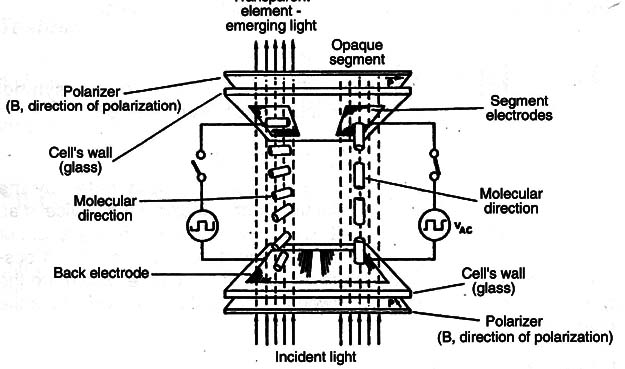The liquid crystal displays use the electrical properties of the molecules of certain substances that can change their positions when an electric field acts on them as shown in Figure 1.

With no electric field present in the substance the molecules are oriented in a manner that lets the light pass through the liquid.
The substance is now transparent. When the electric field is applied, the position of the molecules changes making them cut the light. The substance, under this condition, becomes opaque.
lf transparent electrodes with the pattern to be displayed are placed inside a can filled with a liquid presenting this property, when a voltage is applied in any part or electrode, this part becomes opaque projecting the corresponding image as shown in Figure 2.

The simplest LCD display is the seven-segment type used to display numbers from zero to nine according to excited segments. This type of display is found in clocks, watches, calculators, and timers, just to name a few.
More complex displays include other symbols that can be energized with special signals such as figures in mini games, audio equipment, and radios.
The LCDs need special circuits to become active. The circuit not only recognizes what places of the display must be triggered to show the desired figure, but then also applies an AC voltage.
If a DC voltage is used, an electrolysis phenomenon can occur causing the deterioration of the LCD.
The LCD drivers have special characteristics and are included in the group of the le (integrated circuits) described in other articles in this site.
Symbols and Views
Figure 3 shows the symbols used to represent an LCD. The same figure shows views of some of these displays.

There isn’t any special symbol because many variations can be found in this component based on the application.
Normally a representation that corresponds as near as possible from the final end is adopted and easily recognized by anyone who is reading a schematic diagram or working with the circuit.
Specification
The LCDs are indicated by a part number in most cases. We can separate LCDs in two groups: general-purpose types and special or custom types.
General purpose are those that present generic symbols (normally seven segments or matrix types) that can be used to present information for the projection. The same type of display can present several types of informational messages.
Specific types or custom types are those that are prepared for a determined manufacturer that creates a special configuration of information for a product.
For example, the displays that have the symbol of a company or a figure representing the parts of equipment that are activated at any given time, are examples of these displays.
The electrical characteristics are not so important in this case as they always are driven by a special circuit (usually an integrated circuit).
Where they are found
LCDs are found in any application where numbers, alphanumeric information, or another type of information must be displayed.
Watches, clocks, timers, microwave ovens, radios, telephones, car panels, industrial machine control panels, and facsimile machines are examples of places where LCDs can be found.
Some important information to know about the use of these devices is that they have a power consumption many times lower than the equivalents using LEDs so they are especially suitable for battery-powered applications.
Testing
No simple practical electrical test can provide any information about an LCD. The best way to test is using a specific circuit.



